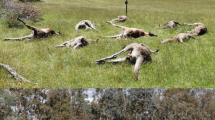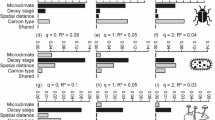Abstract
Ecosystem engineers create physical changes in abiotic and biotic material, and through this process control the availability of resources for other species. Predators that abandon large portions of their prey may be ecosystem engineers that create habitat for carrion-dependent invertebrates that utilize carcasses during critical life-history periods. Between 04-May-2016 and 04-Oct-2016, we sampled beetle assemblages at 18 carcasses of prey killed by pumas and matching control sites in the southern Greater Yellowstone Ecosystem, USA, to measure the extent to which beetle families utilized these carcass “habitats”. We used generalized linear-mixed models and linear-mixed effect models to examine changes in beetle abundance, species richness, and Simpson’s Index of Diversity. We estimated kill rates and carrion production rates for individual pumas to better assess the impact of pumas on invertebrate communities. We collected 24,209 beetles representing 215 species. We identified eight beetle families that had significantly higher abundance at carcasses than control sites. Carcasses had a statistically large to very large effect (determined using Cohen’s d) on beetle abundance, richness, and diversity for the initial 8 weeks of sampling. Our research revealed strong effects of an ecosystem engineer on beetle assemblages while highlighting the potential role of apex predators in creating and modifying physical habitats for carrion-dependent species. This suggests that there may be consequences for invertebrate communities where apex predators exist at reduced numbers or have been eradicated. The ecological role of invertebrates is often overlooked, yet they are essential taxa that provide critical ecological services upon which we depend.

Similar content being viewed by others
References
Ackerman BB, Lindzey FG, Hemker TP (1986) Predictive energetics model for cougars. In: Miller SD, Everett DD (eds) Cats of the world: biology, conservation, and management. National Wildlife Federation, Washington, DC, pp 333–352
Allen ML, Elbroch LM, Wilmers CC, Wittmer HU (2015) The comparative influences of large carnivores on the acquisition of carrion by scavengers. Am Nat 185:822–833. https://doi.org/10.1086/681004
Anderson RS, Peck SB (1985) The carrion beetles of Canada and Alaska: Coleoptera, Silphidae and Agyrtidae (the insects and Arachnids of Canada, Part 13). Canadian Government Publishing Centre, Ottawa
Anderson G, VanLaerhoven S (1996) Initial studies on insect succession on carrion in southwestern British Columbia. J Forensic Sci 41:617–625. https://doi.org/10.1520/JFS13964J
Barton PS, Evans MJ (2017) Insect biodiversity meets ecosystem function: differential effects of habitat and insects on carrion decomposition. Ecol Entomol 42:364–374. https://doi.org/10.1111/een.12395
Barton PS, Cunningham SA, Lindenmayer DB, Manning AD (2013) The role of carrion in maintaining biodiversity and ecological processes in terrestrial ecosystems. Oecologia 171:761–772. https://doi.org/10.1007/s00442-012-2460-3
Danvir RE, Lindzey FG (1981) Feeding behavior of a captive cougar on mule deer. Encyclia 58:50–56
DeVault TL, Rhodes OE, Shivik JA (2003) Scavenging by vertebrates: behavioral, ecological, and evolutionary perspectives on an important energy transfer pathway in terrestrial ecosystems. Oikos 102:225–234. https://doi.org/10.1034/j.1600-0706.2003.12378.x
DiZinno JA, Lord WD, Collins-Morton MB, Wilson MR, Goff ML (2002) Mitochondrial DNA sequencing of beetle larvae (Nitidulidae: omosita) recovered from human bone. J Forensic Sci 47:1337–1339. https://doi.org/10.1520/JFS15571J
Elbroch LM, Wittmer HU (2012) Table scraps: inter-trophic food provisioning by pumas. Biol Lett 8:776–779. https://doi.org/10.1098/rsbl.2012.0423
Elbroch M, Mwampamba TH, Santos MJ, Zylberberg M, Liebenberg L, Minye J, Mosser C, Reddy E (2011) The value, limitations, and challenges of employing local experts in conservation research. Conserv Biol 25:1195–1202. https://doi.org/10.1111/j.1523-1739.2011.01740.x
Elbroch LM, Allen ML, Lowrey BH, Wittmer HU (2014) The difference between killing and eating: ecological shortcomings of puma energetic models. Ecosphere 5:1–16. https://doi.org/10.1890/es13-00373.1
Elbroch LM, Feltner J, Quigley HB (2017a) Human-carnivore competition for antlered ungulates: do pumas select for bulls and bucks? Wildl Res 44:523–533. https://doi.org/10.1071/WR17006
Elbroch LM, O’Malley C, Peziol M, Quigley HB (2017b) Vertebrate diversity benefiting from carrion provided by pumas and other subordinate, apex felids. Biol Conserv 215:123–131. https://doi.org/10.1016/j.biocon.2017.08.026
Gharajehdaghipour T, Roth JD, Fafard PM, Markham JH (2016) Artic foxes as ecosystem engineers: increased soil nutrients lead to increased plant productivity on fox dens. Sci Rep 6:24020. https://doi.org/10.1038/srep24020
Hansen JE, New TR (2005) Use of barrier pitfall traps to enhance inventory surveys of epigaeic Coleoptera. J Insect Conserv 9:131–136. https://doi.org/10.1007/s10841-004-5537-4
Hocking MD, O’Regan SM (2015) Carrion communities as indicators in fisheries, wildlife management, and conservation. In: Benbow ME, Tomberlin JK, Tarone AM (eds) Carrion ecology, evolution, and their applications. CRC Press, Boca Raton, pp 495–516
Hoermann CV, Ruther J, Reibe S, Madea B, Ayasse M (2011) The importance of carcass volatiles as attractants for the hide beetle Dermestes maculatus (De Geer). Forensic Sci Int. 212:173–179. https://doi.org/10.1016/j.forsciint.2011.06.009
Inger R, Cox DTC, Per E, Norton BA, Gaston KJ (2016) Ecological role of vertebrate scavengers in urban ecosystems in the UK. Ecol Evol 6:7015–7023. https://doi.org/10.1002/ece3.2414
Jones CG, Lawton JH, Shachak M (1994) Organisms as ecosystem engineers. Oikos 69:373–386. https://doi.org/10.2307/3545850
Jones CG, Lawton JH, Shachak M (1997) Positive and negative effects of organisms as physical ecosystem engineers. Ecology 78:1946–1957. https://doi.org/10.1890/0012-9658(1997)078%5b1946:PANEOO%5d2.0.CO;2
Jouquet P, Traoré S, Choosai C, Hartmann C, Bignell D (2011) Influence of termites on ecosystem functioning. Ecosystem services provided by termites. Eur J Soil Biol 47:215–222. https://doi.org/10.1016/j.ejsobi.2011.05.005
Kalinová B, Podskalská H, Růzicka J, Hoskovec M (2009) Irresistible bouquet of death—how are burying beetles (Coleoptera: Silphidae: Nicrophorus) attracted by carcasses. Naturwissenschaften 96:889–899. https://doi.org/10.1007/s00114-009-0545-6
Kuznetsova A, Brockhoff PB, Christensen RHB (2017) lmerTEST Package: tests in linear mixed effects models. J Stat Softw 82:1–26. https://doi.org/10.18637/jss.v082.i13
Lövei GL, Sunderland KD (1996) Ecology and behavior of ground beetles (Coleoptera: (Carabidae). Annu Rev Entomol 41:231–256. https://doi.org/10.1146/annurev.en.41.010196.001311
Majka CG (2006) The checkered beetles (Coleopetra: Cleridae) of the maritime provinces of Canada. Zootaxa 1385:31–46. https://doi.org/10.11646/zootaxa.1385.1.2
McLaren BE, Peterson RO (1994) Wolves, moose, and tree rings on isle royale. Science 266:1555–1558. https://doi.org/10.1126/science.266.5190.1555
Midgley JM, Collett IJ, Villet MH (2012) The distribution, habitat, diet and forensic significance of the scarab Frankenbergerius forcipatus (Harold, 1881) (Coleoptera: Scarabaeidae). Afr Invertebr. 53:745–749. https://doi.org/10.5733/afin.053.0214
Moleón M, Sánchez-Zapata JA (2015) The living dead: time to integrate scavenging into ecological teaching. Bioscience 65:1003–1010. https://doi.org/10.1093/biosci/biv101
Moleón M, Sánchez-Zapata JA, Selva N, Donázar JA, Owen-Smith N (2014) Inter-specific interactions linking predation and scavenging in terrestrial vertebrate assemblages. Biol Rev 89:1042–1054. https://doi.org/10.1111/brv.12097
O’Malley C, Elbroch LM, Lendrum PE, Quigley HB (2017) Motion-triggered video cameras reveal spatial and temporal patterns of red fox foraging on carrion provided by mountain lions. PeerJ 6:e5324. https://doi.org/10.7717/peerj.5324
Paine RT (1966) Food web complexity and species diversity. Am Nat 100:65–75. https://doi.org/10.1086/282400
Pechal JL, Benbow ME, Crippen TL, Tarone AM, Tomberlin JK (2014) Delayed insect access alters carrion decomposition and necrophagous insect community assembly. Ecosphere 5:1–21. https://doi.org/10.1890/ES14-00022.1
Power ME, Tilman D, Estes JA, Menge BA, Bond WJ, Mills LS, Daily G, Castilla JC, Lubchenco J, Paine RT (1996) Challenges in the quest for keystones: identifying keystone species is difficult—but essential to understanding how loss of species will affect ecosystems. Bioscience 46:609–620. https://doi.org/10.2307/1312990
Prather CM, Pelini SL, Laws A, Rivest E, Woltz M, Bloch CP, Toro ID, Ho C, Kominoski J, Newbold TAS, Parsons S, Joern A (2012) Invertebrates, ecosystem services and climate Change. Biol Rev 88:327–348. https://doi.org/10.1111/brv.12002
Pringle RM (2008) Elephants as agents of habitat creation for small vertebrates at the patch scale. Ecology 89:26–33. https://doi.org/10.1890/07-0776.1
Prugh LR, Stoner CJ, Epps CW, Bean WT, Ripple WJ, Laliberte AS, Brashares JS (2009) The rise of the mesopredator. Bioscience 59:779–791. https://doi.org/10.1525/bio.2009.59.9.9
Ratcliffe BC (1996) The carrion beetles (Coleoptera: Silphidae) of Nebraska. Bull Univ Nebraska State Museum 13:1–100
Ripple WJ, Estes JA, Beschta RL, Wilmers CC, Ritchie EG, Hebblewhite M, Berger J, Elmhagen B, Letnic M, Nelson MP, Schmitz OJ, Smith DW, Wallach AD, Wirsing AJ (2014) Status and ecological effects of the world’s largest carnivores. Science 343:1241484. https://doi.org/10.1126/science.1241484
Sawilowsky SS (2009) New effect size rules of thumb. J Mod Appl Stat Methods 8:597–599. https://doi.org/10.22237/jmasm/1257035100
Schoenly K, Reid W (1987) Dynamics of heterotrophic succession in carrion arthropod assemblages: discrete series or a continuum of change? Oecologia 73:192–202. https://doi.org/10.1007/BF00377507
Selva N, Fortuna MA (2007) The nested structure of a scavenger community. Proc Biol Sci 274:1101–1108. https://doi.org/10.1098/rspb.2006.0232
Selva N, Jedrzejewska B, Jedrzejewski W, Wajrak A (2005) Factors affecting carcass use by a guild of scavengers in European temperate woodland. Can J Zoo 83:1590–1601. https://doi.org/10.1139/z05-158
Sikes RS, Gannon WL (2011) Guidelines of the American Society of Mammalogists for the use of wild mammals in research. J Mammal 92:235–253. https://doi.org/10.1644/10-MAMM-F-355.1
Simpson EH (1949) Measurement of diversity. Nature 163:688. https://doi.org/10.1038/163688a0
Soulé ME, Estes JA, Miller B, Honnold DL (2005) Strongly interacting species, conservation policy, management, and ethics. Bioscience 55:168–176. https://doi.org/10.1641/0006-3568(2005)055%5b0168:SISCPM%5d2.0.CO;2
Trumbo ST (1992) Monogamy to communal breeding: exploitation of a broad resource base by burying beetles (Nicrophorus). Ecol Entomol 17:289–298. https://doi.org/10.1111/j.1365-2311.1992.tb01060.x
Vaurie P (1955) A revision of the genus Trox in North America (Coleoptera: Scarabaeidae). Bull Am Mus Nat Hist 106:1–89
Venables WN, Ripley BD (2002) Modern applied statistics with S, 4th edn. Springer, New York
Vito M, Muggeo R (2003) Estimating regression models with unknown break-points. Stat Med 22:3055–3071. https://doi.org/10.1002/sim.1545
Wang Y, Yang JB, Wang JF, Li LL, Wang M, Yang LJ, Tao LY, Chu J, Hou YD (2017) Development of the forensically important beetle Creophilus maxillosus (Coleoptera: Staphylinidae) at constant temperatures. J Med Entomol 54:281–289. https://doi.org/10.1093/jme/tjw193
Warnes GR, Bolker B, Lumley T (2018) gtools: Various R Programming Tools. R package version 3.8.1. https://CRAN.R-project.org/package=gtools
Wilmers CC, Crabtree RL, Smith DW, Murphy KM, Getz WM (2003) Trophic facilitation by introduced top predators: grey wolf subsidies to scavengers in Yellowstone National Park. J Anim Ecol 72:909–916. https://doi.org/10.1046/j.1365-2656.2003.00766.x
Wilsey BJ, Potvin C (2000) Biodiversity and ecosystem functioning: importance of species evenness in an old field. Ecology 81:887–892. https://doi.org/10.1890/0012-9658(2000)081%5b0887:BAEFIO%5d2.0.CO;2
Wilson EE, Wolkovich EM (2011) Scavenging: how carnivores and carrion structure communities. Trends Ecol Evol 26:129–135. https://doi.org/10.1016/j.tree.2010.12.011
Winnie J, Creel S (2017) The many effects of carnivores on their prey and their implications for trophic cascades, and ecosystem structure and function. Food Webs 12:88–93. https://doi.org/10.1016/j.fooweb.2016.09.002
Wright JP, Jones CG (2004) Predicting effects of ecosystem engineers on patch-scale species richness from primary productivity. Ecology 85:2071–2081. https://doi.org/10.1890/02-8018
Wright JP, Jones CG (2006) The concept of organisms as ecosystem engineers then years on: progress, limitations, and challenges. Bioscience 56:203–209. https://doi.org/10.1641/0006-3568(2006)056%5b0203:TCOOAE%5d2.0.CO;2
Wright JP, Jones CG, Flecker AS (2002) An ecosystem engineer, the beaver, increases species richness at the landscape level. Oecologia 132:96–101. https://doi.org/10.1007/s00442-002-0929-1
Acknowledgements
We thank the Summerlee Foundation, Pace University, Hofstra University, Charles Engelhard Foundation, Eugene V. & Clare E. Thaw Charitable Trust, National Geographic Society (Grant C236-13), Connemara Fund, Tapeats Foundation, Community Foundation of Jackson Hole, Hogan Films, Ecotour Adventures, Mr. and Mrs. Folger, L. Westbrook, The Scully family, Mr. and Mrs. Haberfeld, Mr. and Mrs. Robertson, Mr. and Mrs. Heskett, Mr. and Mrs. Burgesses, D. Bainbridge, T. Thomas, and A. Smith for financial support of the project. We thank M. Ivie for his assistance to beetle identification. We also thank M. Peziol, C. O’Malley, A. Kusler, J. Williams, B. Smith and S. Smith for contributions to fieldwork. We are grateful for the feedback from the handling editor, two anonymous reviewers, and R. Brandl, Editor in Chief, Terrestrial Invertebrate.
Author information
Authors and Affiliations
Contributions
JMB and LME conceived and designed the experiment. JMB and LME conducted the field work. JMB and MEAL conceived and performed statistical analyses. LS and AK conducted laboratory work on the beetle dataset. JMB and LME wrote the manuscript, with constructive feedback and additions from all authors. HBQ, MMG, and RJS provided institutional support for the work and graduate student training.
Corresponding author
Ethics declarations
Conflict of interest
The authors declare that they have no conflict of interest.
Ethical approval
All procedures performed in this study involving animals were in accordance with the ethical standards of the American Society of Mammals and were approved by two independent Institutional Animal Care and Use Committees (IACUC): the Jackson IACUC (Protocol 027-10EGDBS-060210) and National Park Service IACUC (IMR_GRTE_Elbroch_Cougar_2013-2015).
Additional information
Communicated by Liliane Ruess.
We offer a new predator as an ecosystem engineer. Our study design can reveal the positive role predators have in supporting insect communities. Our design can be applied to predators globally.
Rights and permissions
About this article
Cite this article
Barry, J.M., Elbroch, L.M., Aiello-Lammens, M.E. et al. Pumas as ecosystem engineers: ungulate carcasses support beetle assemblages in the Greater Yellowstone Ecosystem. Oecologia 189, 577–586 (2019). https://doi.org/10.1007/s00442-018-4315-z
Received:
Accepted:
Published:
Issue Date:
DOI: https://doi.org/10.1007/s00442-018-4315-z




